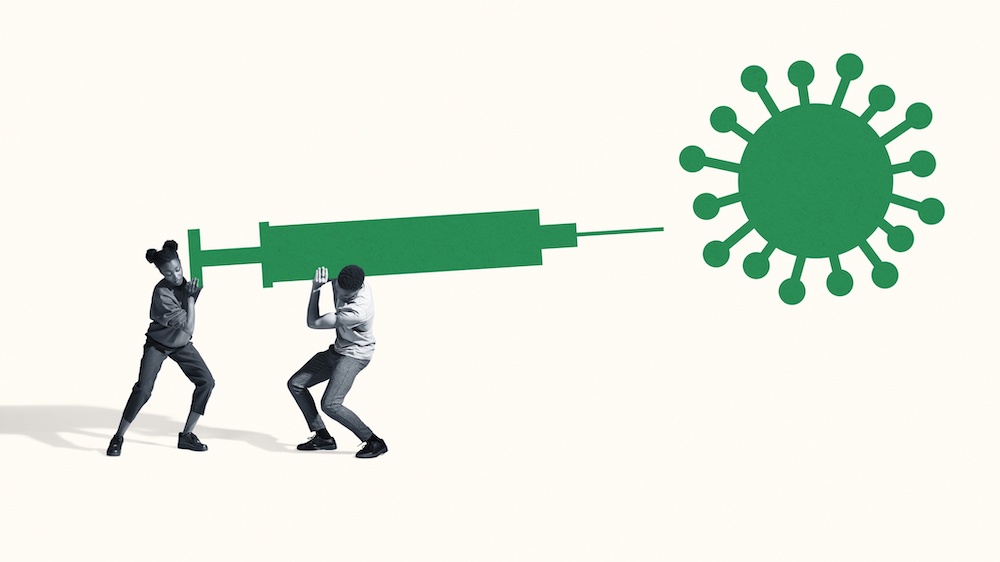If you’re interested in sharing your opinion on any cultural, political or personal topic, create an account here and check out our how-to post to learn more.
Opinions are the writer’s own and not those of Blavity's.
____
The COVID-19 vaccine effort is finally underway across the globe with more than 1.03 billion vaccine doses administered worldwide. However, access to the vaccine remains gentrified.
In cities across the U.S. alone, wealthier, whiter and younger people are getting access to the vaccine, while communities of color are being left behind. As the U.S. continues to expand eligibility, the vaccine equity gap grows. According to the CDC, white people represent 65% with at least one dose of the vaccine, while Black and Hispanic people represent just 8.4% and 11.1%, respectively.
This is possible, in large part, because of a solitary focus on the logistics of getting “shots in arms,” rather than addressing barriers communities of color face when it comes to getting the vaccine. There has been no real effort to communicate in ways that address the underlying issues that cause vaccine hesitancy in underserved communities. The inequities in access to health information that directly contribute to inequities in health care are evident here in the U.S. However, this is not just a US issue. Vaccine inequity goes much broader, as entire countries are being left behind.
Vaccination rates are far behind in certain countries due to a lack of access and resources. For example, while the U.S. currently has a vaccination rate of 68 per 100 people, Mexico has a vaccination rate of 1.9 per 100 people. Likewise, while the UK has vaccinated 68 per 100 people, South Africa has vaccinated less than 1 per 100 people. And many countries have yet to receive even a single dose. Globally, the vaccination rate is estimated to be 11 per 100 people. This is not sufficient. At this current rate, it would take nearly five years to reach a two-dose vaccination in 75% of the global population.
What’s missing is critical communication — to individuals, governments and organizations — that while getting your country’s residents vaccinated is necessary and essential to ending the pandemic, ensuring that all nations have access to the vaccine is equally as important. This should be a priority for the U.S. Ensuring access to the vaccine for people in all nations is not only a global health issue but also an issue of global standing and national security. Distributing vaccines globally is a powerful diplomatic tool — and China, India and Russia are ahead of us.
What can we do to change course? First and foremost, “vaccine nationalism” should be forcefully debunked and global efforts such as The COVAX Facility (co-led by the Coalition for Epidemic Preparedness Innovations (CEPI), Gavi, the Vaccine Alliance and WHO) should be supported. These efforts ensure that low and middle-income countries have access to vaccines that would otherwise be hoarded by wealthier nations. If COVAX is adequately supported, global herd immunity will be reached more quickly, benefiting both public and economic health.
More importantly, it is urgent that we invest in educating and preparing marginalized communities across the globe to receive the COVID-19 vaccine. This requires strategic and responsive communications efforts that acknowledge the historical and cultural context that has led to a distrust of the medical community and vaccine hesitancy in so many places around the world. It also requires that we communicate with people in the formats, languages and ways of reasoning that resonate with them. If we are to increase vaccine reception, we need to follow the science — communication and behavioral science.
People across the globe need their governments and international aid organizations to invest in communication efforts that address COVID-19 vaccine hesitancy head-on. In this time of great loss, people need support to transcend the understandable confusion and anxiety associated with taking a novel medical treatment. This is especially important for communities that have every reason to mistrust the powerful governments and agencies that are funding and orchestrating efforts around COVID-19 recovery.
Gayle Smith, former head of the Obama administration’s Ebola response and now at the helm of the State Department’s COVID-19 global response, must ensure that our response includes not only the vaccine itself but an effective communications approach that addresses vaccine hesitancy. Communication must begin now to ensure the greatest rate of acceptance.
We have no time to waste. We cannot afford five more years of solitude.

